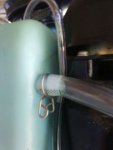Jim Hawkins
Chief Petty Officer
- Joined
- Mar 11, 2013
- Messages
- 499
I just got a boat with a Yamaha 90HP 2 stroke and am checking things out before I use it. The first thing I want to check is the oil injection and the warning indicator specifically. I've done a good bit of reading on the system and understand it is considered very reliable so we've got that out of the way. This is not a thread about the option of disconnecting it.
I pulled the oil reservoir and with the filter/sensor out of the tank I assumed a warning would sound if I turned the key on, but there was nothing. My gauges do not have the fancy lights like the manual shows.
Can anyone help me with a procedure for testing the warning system?
I pulled the oil reservoir and with the filter/sensor out of the tank I assumed a warning would sound if I turned the key on, but there was nothing. My gauges do not have the fancy lights like the manual shows.
Can anyone help me with a procedure for testing the warning system?





















